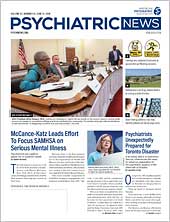The use of video-based psychiatry has grown dramatically over the past decade, spurred by the proliferation of high-quality videoconferencing technologies and more health care payers who are willing to reimburse doctors for video-based services. “If you look at job adverts, it’s amazing now how many include telepsychiatry as part of the job description,” said Peter Yellowlees, M.B.B.S., M.D., a professor of psychiatry at UC Davis, a member of APA’s Committee on Telepsychiatry, and past president of the American Telemedicine Association (ATA).
APA and the ATA in May released “Best Practices in Videoconferencing-Based Telemental Health,” a guide for mental health providers who want to begin using interactive videoconferencing to offer services to their patients.
This updated guide, which consolidates resource materials previously published by both organizations, contains dozens of recommendations to inform practitioners how to use videoconferencing to provide safe, effective, and compliant care.
The joint guide, written by members from the APA Committee on Telepsychiatry and the ATA’s Telemental Health Specialist Interest Group, was developed to be used by practitioners at any level, including psychiatrists as well as clinical psychologists and social workers.
“The ATA had previously released telemental health guidelines, but by working with the APA and taking advantage of their expertise, I believe these new guidelines are more succinct, more readable, and offer clearer clinical guidance,” said Carolyn Turvey, Ph.D., a clinical psychologist at the University of Iowa Carver College of Medicine and one of the guide’s co-authors.
The guide is the latest telepsychiatry resource to join APA’s ever-expanding Telepsychiatry Toolkit. The guide broadly considers three essential components of videoconferencing-based mental health practice:
•
Administrative considerations, including information on program development, legal and regulatory issues (including information on licensure and prescribing), and standard operating procedures.
•
Technical considerations, including videoconferencing platform requirements, HIPAA and state privacy requirements, and appropriate room set-up for video sessions.
•
Clinical considerations, including patient and setting selection, ethical issues, and factors to consider when treating specific populations (children and adolescents, patients in correctional settings, military, and more).
Within each component, the guide provides recommendations or requirements delineated by one of three strength levels: “shall,” “should,” or “may.” “Shall” indicates that an action is required whenever feasible and practical; “should” indicates an action that is not mandatory but is considered optimal practice; and “may” indicates additional points that practitioners can implement to further optimize their use of videoconferencing services in their practice.
The guide authors highlighted that the new resource is not intended to be an exhaustive list of how to conduct mental health care using video. It should be used as a practical starting point for practices looking to set up or expand use of videoconferencing services.
Yellowlees, who coauthored the guide, noted that people interested in learning more about telepsychiatry should check out APA’s online resources, including more than 30 short educational videos dealing with key issues such as licensure, reimbursement, training, and clinical issues. Yellowlees and Jay H. Shore, M.D., M.P.H., a professor of psychiatry at the University of Colorado-Anschutz Medical Campus in Denver, also coauthored a new book on the subject, “Telepsychiatry and Health Technologies: A Guide for Mental Health Professionals.” ■
“Best Practices in Videoconferencing-Based Telemental Health,” APA’s Telepsychiatry Toolkit, and other telepsychiatry resources can be accessed
here.
